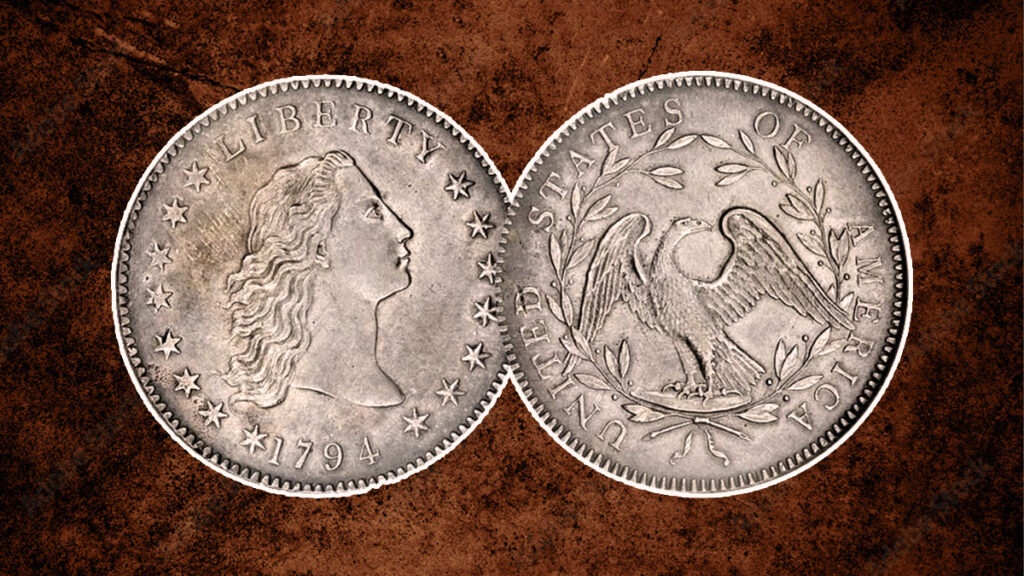
The Flowing Hair dollar was the first US dollar coin, made in 1794 and 1795. It was inspired by the Spanish dollar. In 1791, Congress agreed to create a national mint, as suggested by Alexander Hamilton. President George Washington supported this in his 1791 State of the Union address. The Coinage Act of 1792 officially established the Mint, but it wasn’t until 1794 that silver and gold coins were made. Robert Scot designed the Flowing Hair dollar, which was replaced by the Draped Bust dollar in 1795.
1794 Flowing Hair Silver Dollar Coin Specifications
Years Of Issue: 1794-95
Mintage: High: 160,295 (1795); Low: 1,758 (1794)
Alloy: 89.24% silver, 10.76% copper
Weight: ±26.96 g
Diameter: ±39-40 mm
Edge: Lettered: HUNDRED CENTS ONE DOLLAR OR UNIT, with decorations or ornaments between the words
OBV Designer: Robert Scot
REV Designer: Robert Scot
History of the 1794 Flowing Hair Silver Dollar
In the late 1700s, many influential Americans wanted a central mint for official US coins, but proposals were rejected due to funding issues and opposition favoring state-issued coins. States used various coins and tokens, including Spanish dollars.
In 1789, the US Constitution gave Congress power over coinage. Treasury Secretary Alexander Hamilton proposed a US mint in 1791, based on studies of the monetary system and assays of Spanish dollars. He recommended the US dollar’s silver content be based on the average of tested pesos.
Congress passed a resolution on March 3, 1791, authorizing a federal mint without specifics or funding.
How Much Is a 1794 Silver Dollar Worth?
A Liberty Coin from 1794, in used condition, can fetch anywhere from $70,000 to $975,000, according to the NGC Price Guide as of May 2024. However, on the open market, 1794 Silver Dollars in perfect, unused condition can sell for as high as $7,000,000.
Why Is the 1794 Flowing Hair Dollar Valuable?
The 1794 Flowing Hair Dollar is valuable because these are rare in most grades and these are known for their beautiful design and awareness of detail.
Identifying a Genuine 1794 Flowing Hair Dollar
To identify a genuine 1794 Flowing Hair Dollar:
- It weighs the same as a Spanish dollar but appears to be of finer metal.
- One side shows a head with flowing hair, encircled by Fifteen Stars, with “LIBERTY” at the top and the date “1794” at the bottom.
- The reverse side features a Bald Eagle perched on a rock within a wreath, with specific details such as the number of leaves and berries on the wreath, and the positioning of certain elements like the eagle’s wing.
- The design includes nuances like the arrangement of curls on the head of Liberty and specific features of the eagle and wreath.
- Notably, the 1794 design has a fuller cheek and more pronounced jawline on the head of Liberty compared to the 1795 version.
- The reverse side of the coin has distinct characteristics, including the positioning of the eagle, wreath details, and the extent of the rock under the eagle’s feet.
These features help distinguish a genuine 1794 Flowing Hair Dollar from later editions.
Collecting Tips for the 1794 Flowing Hair Dollar
Collecting Tips for the 1794 Flowing Hair Dollar:
- Rarity: Understand that the 1794 Flowing Hair Dollar is rare in most grades, making it a highly sought-after collectible.
- Condition: Look for coins in the best possible condition. While even circulated versions can be valuable, pristine, unused specimens fetch the highest prices.
- Authentication: Due to the value and rarity of these coins, ensure authenticity by consulting reputable experts or organizations, especially when purchasing from sources outside of established numismatic channels.
- Documentation: Keep records of provenance, including certificates of authenticity or grading reports, to maintain the coin’s value and authenticity over time.
- Preservation: Store and handle the coin carefully to prevent damage. Consider using protective cases or holders to safeguard its condition.
Also Read – 1933 Saint Gaudens Double Eagle: A Complete Guide
Conclusion:
The 1794 Flowing Hair Dollar holds significant historical and numismatic value, being the first US dollar coin and featuring a captivating design by Robert Scot. Its rarity, beauty, and historical importance make it a prized possession for collectors. By understanding its unique characteristics, verifying authenticity, and preserving its condition, collectors can appreciate and protect this iconic piece of American numismatic history for generations to come.
